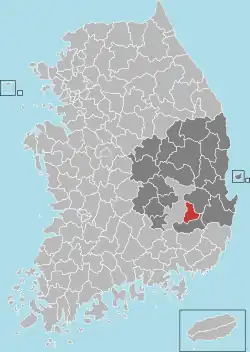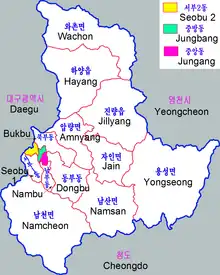Gyeongsan
경산시 | |
|---|---|
| Korean transcription(s) | |
| • Hangul | 경산시 |
| • Hanja | 慶山市 |
| • Revised Romanization | Gyeongsan-si |
| • McCune-Reischauer | Kyŏngsan-si |
 | |
 Flag  Emblem of Gyeongsan | |
 Location in South Korea | |
| Country | |
| Region | Yeongnam |
| Administrative divisions | 2 eup, 6 myeon, 6 dong |
| Area | |
| • Total | 411.58 km2 (158.91 sq mi) |
| Population (December 31, 2009) | |
| • Total | 236,459 |
| • Density | 574.52/km2 (1,488.0/sq mi) |
| • Dialect | Gyeongsang |
| Area code | +82-53-8xx |
Gyeongsan (Korean pronunciation: [kjʌŋ.san] is satellite city in North Gyeongsang Province, South Korea. Its western border abuts the metropolitan city of Daegu, and much of Gyeongsan lies within the Daegu metropolitan area.
Numerous universities are located in Gyeongsan, such as Yeungnam University, Daegu University, Daekyeung University, Catholic University of Daegu, Daegu Haany University and Gyeongil University.
Symbols of City
The city flower is the magnolia which grows well even in poor soil conditions. The city bird is the magpie. Its clear song reflects the bright and hopeful spirits of citizens. The city tree is the ginkgo. It symbolizes the constant prosperity, perseverance and elegant traits of Gyeongsan citizens.[1]
International Chemistry Olympiad
Gyeongsan was the host for the 38th International Chemistry Olympiad (2 July 2006 - 11 July 2006).
Twin towns – sister cities
 Gangdong (Seoul), South Korea
Gangdong (Seoul), South Korea Jōyō, Japan
Jōyō, Japan Sinan, South Korea
Sinan, South Korea Xihai'an, China
Xihai'an, China
Administrative districts

Gyeongsan is divided into 3 eup, 5 myeon and 7 dong. Amnyang was promoted to eup status on 1 January 2020.
| Name | Hangeul | Hanja |
|---|---|---|
| Hayang-eup | 하양읍 | 河陽邑 |
| Jillyang-eup | 진량읍 | 珍良邑 |
| Amnyang-eup | 압량읍 | 押梁邑 |
| Wachon-myeon | 와촌면 | 瓦村面 |
| Jain-myeon | 자인면 | 慈仁面 |
| Yongseong-myeon | 용성면 | 龍城面 |
| Namsan-myeon | 남산면 | 南山面 |
| Namcheon-myeon | 남천면 | 南川面 |
| Jungang-dong | 중앙동 | 中央洞 |
| Dongbu-dong | 동부동 | 東部洞 |
| Seobu 1-dong | 서부1동 | 西部一洞 |
| Seobu 2-dong | 서부2동 | 西部二洞 |
| Nambu-dong | 남부동 | 南部洞 |
| Bukbu-dong | 북부동 | 北部洞 |
| Jungbang-dong[3] | 중방동 | 中方洞 |
Location
Gyeongsan city lies mid-eastern part of Gyeongsangbuk-do. It is close to several big cities such as Daegu, Ulsan, Busan and many other places.
Climate
The climate is mild because of its southern location. However, being landlocked makes its climate continental.
The amount of rainfall is less than the average yearly rainfall of Korea, due to its geographical characteristics.[4]
| Climate data for Gyeongsan (1993–2020 normals) | |||||||||||||
|---|---|---|---|---|---|---|---|---|---|---|---|---|---|
| Month | Jan | Feb | Mar | Apr | May | Jun | Jul | Aug | Sep | Oct | Nov | Dec | Year |
| Mean daily maximum °C (°F) | 5.7 (42.3) |
8.7 (47.7) |
14.5 (58.1) |
20.8 (69.4) |
26.2 (79.2) |
29.2 (84.6) |
31.3 (88.3) |
32.0 (89.6) |
27.3 (81.1) |
22.2 (72.0) |
14.9 (58.8) |
7.6 (45.7) |
20.0 (68.0) |
| Daily mean °C (°F) | 0.5 (32.9) |
3.0 (37.4) |
8.0 (46.4) |
14.0 (57.2) |
19.4 (66.9) |
23.0 (73.4) |
26.2 (79.2) |
26.7 (80.1) |
21.7 (71.1) |
15.7 (60.3) |
8.8 (47.8) |
2.2 (36.0) |
14.1 (57.4) |
| Mean daily minimum °C (°F) | −4.0 (24.8) |
−2.0 (28.4) |
2.5 (36.5) |
8.1 (46.6) |
13.4 (56.1) |
18.2 (64.8) |
22.5 (72.5) |
22.9 (73.2) |
17.5 (63.5) |
10.5 (50.9) |
3.6 (38.5) |
−2.4 (27.7) |
9.2 (48.6) |
| Average precipitation mm (inches) | 19.1 (0.75) |
26.9 (1.06) |
52.4 (2.06) |
77.7 (3.06) |
81.9 (3.22) |
124.5 (4.90) |
218.9 (8.62) |
231.1 (9.10) |
151.9 (5.98) |
53.8 (2.12) |
33.4 (1.31) |
20.1 (0.79) |
1,091.7 (42.98) |
| Average precipitation days (≥ 0.1 mm) | 3.5 | 3.9 | 6.3 | 6.9 | 7.5 | 8.0 | 12.2 | 11.1 | 8.1 | 4.3 | 4.3 | 3.1 | 79.2 |
| Source: Korea Meteorological Administration[5] | |||||||||||||
Religion
- Hwanseongsa, temple
See also
References
- ↑ "Gyeongsan Symbols, Gyeongsan City".
- ↑ "Sister/Friend Cities". gbgs.go.kr. Gyeongsan. Retrieved 2020-04-13.
- ↑ <Original data from city webpage
- ↑ "welcome to Gyeongsan City Hall".
- ↑ "Climatological Normals of Korea (1991 ~ 2020)" (PDF) (in Korean). Korea Meteorological Administration. Archived from the original (PDF) on 29 January 2022. Retrieved 7 June 2023.
External links
35°49′N 128°44′E / 35.817°N 128.733°E
